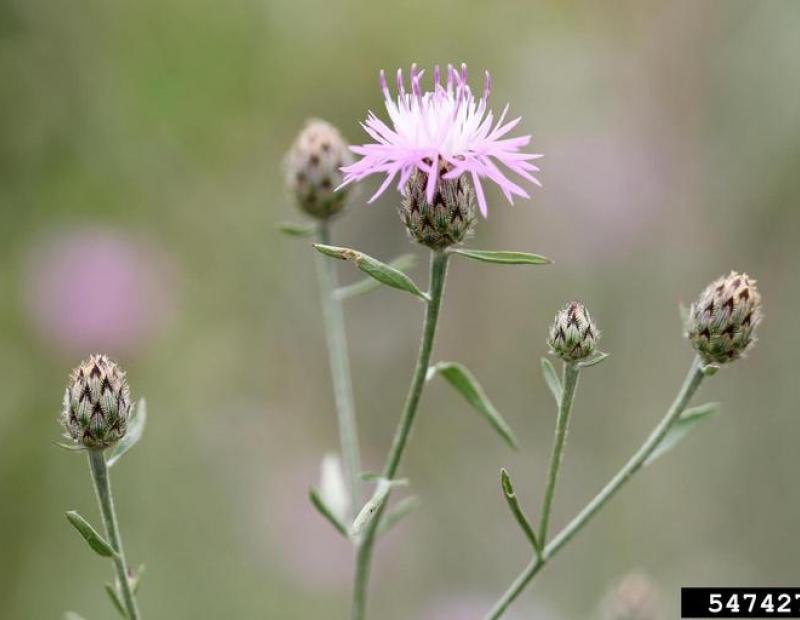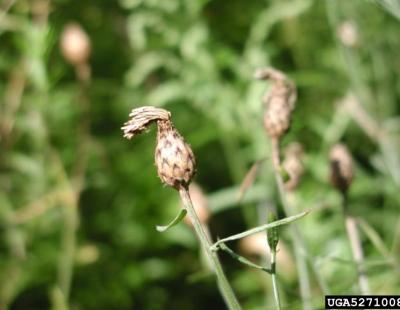Vertical Tabs
- Spotted knapweed is a member of the Aster family (Asteraceae).
- Native to eastern Europe, spotted knapweed is a short-lived perennial belonging to the daisy family. The species forms a basal rosette of deeply divided blueish-green leaves which eventually produce a flowering spike displaying summer-blooming, thistle-like flowers lavender-purple in color. (8)
Leaves
Leaves are hairy, covered in conspicuous shiny specks, alternately arranged, and deeply lobed, particularly within the plant’s basal rosette.
Flowers
Flowers bloom towards midsummer in the Hudson Valley, and are approximately an inch across. Thistle-like in shape, the flowers are subtended by green, dryish bracts, each with a black tip, from which the species draws its name. (8)
A highly aggressive, short-lived perennial, spotted knapweed is a conspicuous invader of old fields and waste places in the Hudson valley, quickly outcompeting native species and homogenizing the vegetative community. The early formation of deep taproots may help the species acquire nutrients more rapidly and increase the aridity of soils, quickly altering habitat characteristics for other species present. Additionally, spotted knapweed is allelopathic and interferes with the germination and establishment of other plants. (11)
Biological Control
As of this writing at least 13 insects from spotted knapweed’s native Eurasian range are in use against this invasive species. Several attack the species’ flower heads, the rest, its root system. These insects are most effective when feeding in tandem on a population of spotted knapweed. (7)
Manual or Mechanical Control
Pulling / Digging Up: Consistent pulling by hand is effective against spotted knapweed, so long as all the species’ extensive taproot is removed. This is a very time and labor-intensive effort and useful only for small populations. (6)
Mowing: Although consistent mowing prior to or at flowering onset does diminish flowering and seed set somewhat it is not a very effective method of control. (2)
Girdling: Not applicable
Prescribed Fire: The hotter the controlled burn, the more effective it will be at controlling spotted knapweed. The plant’s deep taproot does render the species somewhat resistant to moderate blazes. (11)
Prescribed Grazing: Grazing by sheep and goats has proven effective at reducing the number of stems of spotted knapweed, particularly seedlings and young plants. This is especially effective when combined with the use of other biological controls such as the knapweed root or flower weevil. (6, 2)
Soil Tilling: Although spotted knapweed will not survive consistent annual tiling, this is not an acceptable method of management in natural areas. It can be utilized effectively on a small scale in cultivated fields or gardens. (11)
Mulching: Mulching with black plastic is effective at controlling small areas of spotted knapweed. (13, 14)
Solarization; See above. This method may kill seedlings and reduce the seed bank due to high summer time temperatures beneath mulch. (14)
Hot Foam Spray: Not applicable
Chemical Control
The pesticide application rates and usage herein are recommendations based on research and interviews with land managers. When considering the use of pesticides, it is your responsibility to fully understand the laws, regulations and best practices required to apply pesticides in a responsible manner. At times, the pest you seek to treat may not be on a pesticide label, requiring a 2ee exemption from NYSDEC. Always thoroughly read the label of any pesticide and consult the NYSDEC or a licensed pesticide applicator with questions.
Foliar Spray: 2-4D, Clopyarlid, Dicamba and picloram are all effective against spotted knapweed when applied during active growth. Dicamba and 2-4D provide inconsistent control and must be applied for at least two seasons to control mature plants. Glyphosate is effective against spotted knapweed but is not selective: the slender form of spotted knapweed makes it very difficult to avoid non-target plants when performing management via foliar spray. Repeat applications of all herbicides will be necessary to control emerging seedlings for at least five years after initial treatment. Always read and follow all directions on the label. Follow up treatment will be necessary the following season. (12)
Cut Stump: Not applicable
Basal Bark: Not applicable
Hack-And-Squirt
Stem Injection: Not applicable
Pre-Emergent Spray: Not applicable
General management overview and recommendation
Sequential herbicide treatments will provide the highest rate of control of spotted knapweed. Two applications may be necessary during the first year of control, and all managed sites will need to be retreated in the following season— possibly for retreatment of mature plants and to target newly emerged seedlings. As an alternative, managers may choose to employ grazers and mowing to reduce seed set and stem count before applying herbicides. For very small infestations, hand pulling will eventually achieve eradication.
Post treatment monitoring
Depending on the management method employed, controlled populations should be revisited throughout the growing season for repeat management activities in approximately 2-3 weeks post treatment. Due to the species long-lived seed bank, all managed sites should be visited for at least 5 years to prevent germination of viable seed.
Disposal Methods
Waste material must be thoroughly dried and can then be composted, burned, or disposed of in a landfill. Taproots have the potential to re-sprout. All viable seed must be bagged and disposed of.
REFERENCES
- https://www.dec.ny.gov/docs/lands_forests_pdf/isprohibitedplants2.pdf
- https://www.fs.fed.us/database/feis/plants/forb/censtom/all.html
- Davis, Edward S.; Fay, Peter K. 1989. The longevity of spotted knapweed seed in Montana. In: Fay, Peter K.; Lacey, John R., eds. Proceedings: knapweed symposium; 1989 April 4-5; Bozeman, MT. Bozeman, MT: Montana State University: 67-72. [37797]
- https://onlinelibrary.wiley.com/doi/abs/10.1111/j.1365-3180.1980.tb00049.x
- http://www.nrcresearchpress.com/doi/abs/10.4141/cjps79-060#.WzKN0CMrIy4
- http://www.bioone.org/doi/abs/10.1614/IPSM-D-15-00034.1
- http://www.mda.state.mn.us/plants/pestmanagement/weedcontrol/noxiouslist...
- https://www.eddmaps.org/Species/subject.cfm?sub=50209
- https://gobotany.newenglandwild.org/species/centaurea/stoebe/
- https://research.libraries.wsu.edu/xmlui/handle/2376/1148?show=full
- https://efotg.sc.egov.usda.gov/references/public/MN/SpottedKnapweedMN.pdf
- https://www.invasive.org/gist/moredocs/cenmac02.pdf
- https://wric.ucdavis.edu/information/natural%20areas/wr_C/Centaurea_stoe...
- https://appliedeco.org/wp-content/uploads/CEPR-report-2009_compressed.pdf











